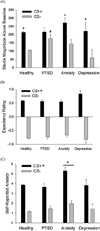Conditioned fear and extinction learning performance and its association with psychiatric symptoms in active duty Marines
- PMID: 25444643
- PMCID: PMC4345165
- DOI: 10.1016/j.psyneuen.2014.09.030
Conditioned fear and extinction learning performance and its association with psychiatric symptoms in active duty Marines
Abstract
Background: Posttraumatic Stress Disorder (PTSD) is a major public health concern, especially given the recent wars in Iraq and Afghanistan. Nevertheless, despite a sharp increase in the incidence of psychiatric disorders in returning veterans, empirically based prevention strategies are still lacking. To develop effective prevention and treatment strategies, it is necessary to understand the underlying biological mechanisms contributing to PTSD and other trauma related symptoms.
Methods: The "Marine Resiliency Study II" (MRS-II; October 2011-October 2013) Neurocognition project is an investigation of neurocognitive performance in Marines about to be deployed to Afghanistan. As part of this investigation, 1195 Marines and Navy corpsmen underwent a fear conditioning and extinction paradigm and psychiatric symptom assessment prior to deployment. The current study assesses (1) the effectiveness of the fear potentiated startle paradigm in producing fear learning and extinction and (2) the association of performance in the paradigm with baseline psychiatric symptom classes (healthy: n=923, PTSD symptoms: n=42, anxiety symptoms: n=37, and depression symptoms: n=12).
Results: Results suggest that the task was effective in producing differential fear learning and fear extinction in this cohort. Further, distinct patterns emerged differentiating the PTSD and anxiety symptom classes from both healthy and depression classes. During fear acquisition, the PTSD symptom group was the only group to show deficient discrimination between the conditioned stimulus (CS+) and safety cue (CS-), exhibiting larger startle responses during the safety cue compared to the healthy group. During extinction learning, the PTSD symptom group showed significantly less reduction in their CS+ responding over time compared to the healthy group, as well as reduced extinction of self-reported anxiety to the CS+ by the end of the extinction session. Conversely, the anxiety symptom group showed normal safety signal discrimination and extinction of conditioned fear, but exhibited increased baseline startle reactivity and potentiated startle to CS+, as well as higher self-reported anxiety to both cues. The depression symptom group showed similar physiological and self-report measures as the healthy group.
Discussion: These data are consistent with the idea that safety signal discrimination is a relatively specific marker of PTSD symptoms compared to general anxiety and depression symptoms. Further research is needed to determine if deficits in fear inhibition vs. exaggerated fear responding are separate biological "domains" across anxiety disorders that may predict differential biological mechanisms and possibly treatment needs. Future longitudinal analyses will examine whether poor learning of safety signals provides a marker of vulnerability to develop PTSD or is specific to symptom state.
Keywords: Anxiety; Extinction; Fear; Fear inhibition; Military; PTSD; Safety signal; Startle.
Copyright © 2014 Elsevier Ltd. All rights reserved.
Conflict of interest statement
The rest of the authors report no conflicts of interest associated with the current manuscript.
Figures


References
-
- Admon R, Milad MR, Hendler T. A causal model of post-traumatic stress disorder: disentangling predisposed from acquired neural abnormalities. Trends Cogn. Sci. 2013;7:337–347. - PubMed
-
- Baker DG, Nash WP, Litz BT, Geyer MA, Risbrough VB, Nievergelt CM, et al. Predictors of risk and resilience for posttraumatic stress disorder among ground combat Marines: methods of the Marine Resiliency Study. Prev. Chronic Dis. 2012;9:110134. http://dx.doi.org/10.5888/pcd9.110134 - DOI - PMC - PubMed
Publication types
MeSH terms
Grants and funding
LinkOut - more resources
Full Text Sources
Other Literature Sources
Medical
Research Materials

